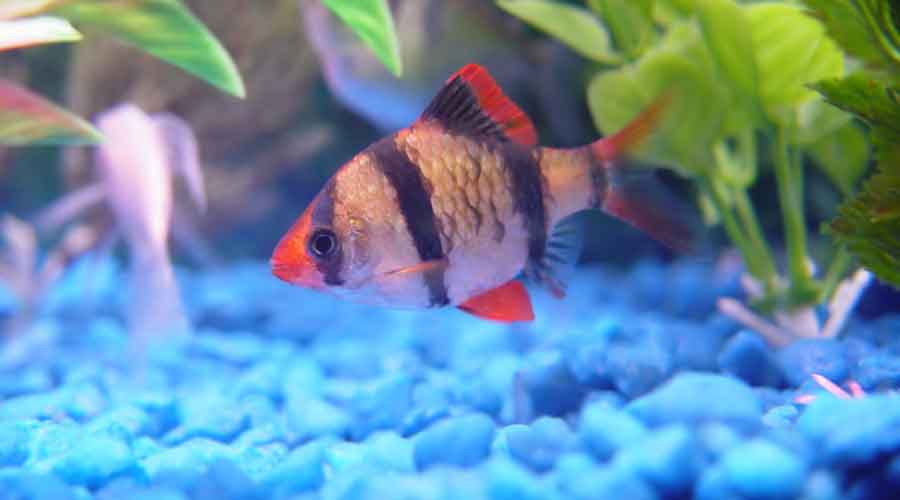Tiger Barbs are an attractive fish that are easy to care for and small enough for most tropical freshwater tanks. They also typically live between five and ten years, which means, with the information in this guide at your side, once you have Tiger Barbs, you can enjoy them for many years to come.
About Tiger Barbs
The Tiger Barb (scientific name: Puntius tetrazona) are Cyprinids from the family Cyprinidae, along with carps and true minnows. These fish are native to the areas of Malaysia and Borneo. However, Tiger Barbs are also found in places such as Cambodia and Thailand; and the waters off the island of Sumatra. T. Barbs were later introduced in Australia, Colombia, Singapore, and the United States.
Noted for their black stripes and red or orange-tipped fins and tail, they are otherwise a shimmering silver and gold in color. Through selective breeding, however, you can also find Tiger Barbs nowadays in a host of other colors, including albino, red, black, and green.
Keeping T. Barbs
T. Barbs prefer a tank at least 20-30 gallons in size. They also desire a well-planted tank with many ornaments to swim through and around. Be careful to use larger features like driftwood and rocks sparingly, however, to allow plenty of room for these vigorous swimmers to move about freely.
Lots of plants in the tank also allow Barbs plenty of space to breed, if that’s something you desire. If it is, however, be aware that Barbs are also prone to eat all their eggs. This is another reason to place a lot of plant matter in the tank, as the eggs can often get lost in their folds.
T. Barbs are a generally hardy fish that are prone to no particular diseases, although they can be susceptible to common fish illnesses like cottonmouth and ich. Typically, they prefer clean, highly oxygenated water. To protect the health of your T. Barbs, be sure you use adequate filtration and maintain these water conditions:
- Water temperature – Between 74 and 79 degrees Fahrenheit
- pH – Mildly-acidic, between 6.0 and 7.0
- Water hardness (KH) – Between four and 10 dGH
Also, before adding T. Barbs or any other fish to your tank, you should always have the water thoroughly conditioned and cycled first.
Finish out your tank with a fine substrate and decent lighting to give your T. Barbs their optimum environment.
Feeding Tiger Barbs
As T. Barbs are omnivores, they need a variety of foods in their diet to stay healthy and thrive, including both vegetable and meat sources. Fortunately, T. Barbs will eat nearly any food you feed them, though best is to pair a high-quality flake fish food with frozen meats like bloodworms, daphnia, and brine shrimp. More nutritious food choices will help support your T. Barbs’ vibrant colors.
Tankmates
An active and playful freshwater fish, Tiger Barbs, are the happiest swimming in schools. You should, therefore, plan on having several T. Barbs in your tank instead of just one, for the most success with them. A minimum of five or six T. Barbs in a single tank is most recommended. This way, they spend most of their time chasing each other around the tank rather than pestering the different species of fish in the fish tank with them.

Barbs are also a semi-aggressive fish, however, known to harass and nip at the fins of bigger, more docile, and slower-moving fish. So, you should be careful about what other fish you keep with them in the same tank. The Tiger Barb is most compatible with other kinds of Barbs, such as Cherry, Gold, Rosy, Denison, Checker, Spanner, Spotted, and Golden Dwarf Barbs. They’ll even nip at other Barbs, however, including other Tigers, particularly if there are fewer of them in the tank. To prevent your T. Barbs from nipping, both other Barbs and other species of fish, make sure to keep a large-enough school of T. Barbs in your tank at all times, particularly if its a community tank with other species of fish.
You can keep T. Barbs with Angelfish and various types of Cichlids, including Malawian, Tanganyikan, New World, and Miscellaneous African Cichlids. You must, however, use caution when doing so, as these are also semi-aggressive fish. You can also keep them with other schooling or fast-moving fish like Danios, Platys, Loaches, and Tetras. Bottom-dwellers like Catfish tend to fare fine with T. Barbs as well, as the Barbs generally leave them alone.
That said, you could try keeping Barbs with nearly any other species of fish, provided you have enough T. Barbs in the school to entertain themselves and prevent them from bothering the other fish. Success in such an endeavor, however, can be hit-or-miss.
Least recommended is to keep T. Barbs with any fish that have long and flowing tails and fins, like the Betta fish, as your T. Barbs are likely to make a target of it.
Also, with pet blue crayfish, Barbs can sometimes end up becoming a meal for a cray. This is because crayfish are very aggressive creatures. However, with the right sized tank, Barbs can work just fine.
Recap
For a tank always abuzz with color and activity, Tiger Barbs make an excellent choice of fish. As a common breed, they provide endless entertainment while their ease of care allows them to fit into almost any home and lifestyle.

